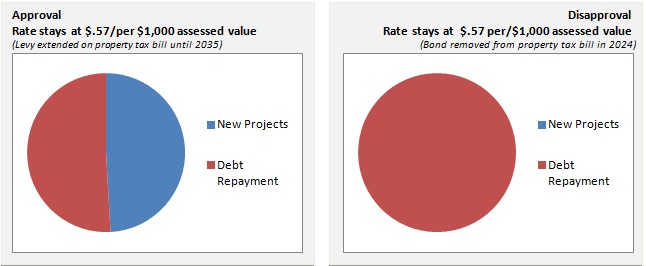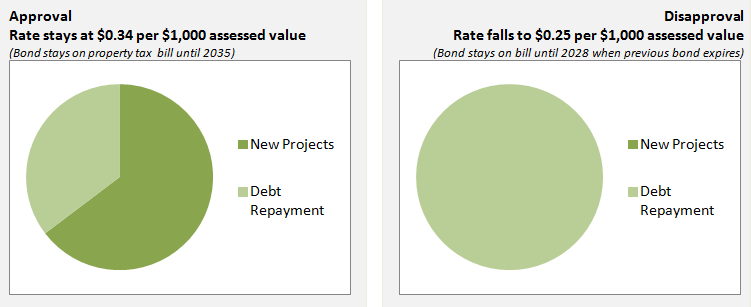Click here to download a PDF of this Policy Brief which includes sources and citations
Key Findings
- Proposition 1 would convert Spokane’s popular street bond into a levy until 2035, funding numerous road projects around the city.
- Proposition 2 would extend Spokane’s parks bond to 2035 to fund renovations to Riverfront Park.
- Approval of both measures would not increase the current yearly property tax burden, but would increase the amount of debt taxpayers owe in the future.
- Rejection of Proposition 2 would lower the current property tax burden.
- Unlike the previous bond, all of the street projects under the proposed new levy will not be announced unless or until citizens approve the measure.
Introduction
This November, Spokane voters will make two decisions that will affect their property tax burden for years to come. Citizens are being asked to convert the city’s popular street bond program into a 20-year property tax levy. Voters are also being asked to approve a 20-year, $64.3 million bond measure to finance reconstruction of Spokane’s historic Riverfront Park.
The ballot measures that will appear before voters read as follows;
Proposition No. 1 - City of Spokane - Levy for Improved and Integrated Streets
"The Spokane City Council adopted Resolution No. 2014-0085, approving a levy proposition to improve and repair the city’s streets and terminate the use of the existing $0.57 property tax assessment for repayment of the 2004 street bond. This proposition would authorize a property tax levy lid lift commencing in 2015 of $0.57 per $1,000 of assessed valuation, resulting in no net increase in the 2015 tax rate. The levy funds would be used to pay for street repairs and improvements and would be the basis for subsequent levies for 20 years, all as provided in the resolution. Should this proposition be:"
Approved
Rejected
Proposition No. 2 - City of Spokane - Riverfront Park General Obligation Bonds - $64,300,000
"The City Council of the City of Spokane passed Resolution No. 2014-0084 approving a plan to finance the renovation, improvement and modernization of the aging infrastructure of Riverfront Park, including the Looff Carrousel building, U.S. Pavilion, Ice Rink, Skyride and Park facilities with no net increase in the current annual tax levy for Parks. This proposition authorizes the City to finance the renovation of Riverfront Park buildings, facilities and infrastructure; enhance security and safety facilities; capital facilities of Riverfront Park and the Parks system. General obligation bonds would be issued in a maximum principal amount of $64,300,000, maturing within 20 years from date of issue, and repaid from an annual excess levy on real property, all as provided in the Resolution. Should this proposition be:"
Approved
Rejected
Because the streets levy proposal would continue an existing tax, approval of both Proposition 1 and Proposition 2 would not affect a property owner’s current tax rate. It would, however, extend payoff periods. However, because a previous parks bond is set to be paid in full at the end of 2014, if Proposition 2 were rejected, the property tax burden imposed by the city would slightly decrease.
Background
Spokane property owners currently pay $0.91 per $1,000 of assessed value for streets and parks in the city of Spokane, or $182 per year on a typical $200,000 home. If both Proposition 1 and Proposition 2 are approved, citizens would still pay $0.91 per $1,000. The change, however, is that citizens would pay the tax longer and the measures would change how the taxpayer money is used.
Streets Levy Scenarios and Impact on Property Tax Rates

Parks Bond Scenarios and Impact on Property Tax Rates

To pass, the parks bond will need a 60 percent supermajority vote, while the streets levy can be approved with a simple majority.
The Streets Bond Measure
In 2004, the citizens of Spokane overwhelmingly approved a 20-year streets bond. The bond money was used to pay for reconstruction of more than 110 miles of roadways in the city over 10 years. As promised by then-Mayor Jim West, street projects were delivered on time and on budget.
Much of the reason for the approval and success of the 2004 streets bond was because a plan was laid out before citizens cast their ballots. City leaders at the time were very specific about what projects would be completed, when they would be completed, and how citizens could track construction progress. The accountability and oversight of the measure was substantial and was a model that could be used by communities across the country.
While the street projects were completed in 10 years, the bond was set to be paid for over a 20-year period. That means citizens in Spokane will be paying for already-completed projects funded by the 2004 bond measure until 2024, regardless of whether the 2014 ballot measure passes.
City leaders now want to convert the street repair bonds into a property tax levy, and then extend the taxpayer burden further by 10 years, keeping the tax in place until 2035. By doing that, city leaders say they would be able to make another $114 million in street repairs over the next 20 years, plus take advantage of utilities and matching taxpayer funds from the state. In total, city leaders say $489 million would be spent on city street repairs over the next 20 years.
Without approval, Spokane would have to find other ways to fix streets within existing tax revenues.
Parks Bond & Riverfront Park
Before 1974, the 100-acre site of today’s Riverfront Park was occupied by a network of switches, sidings and rail lines. The historic clock tower – an icon of the Spokane skyline - is the only remnant that connects the current park to its railroad history.
Millions of dollars were spent to convert the rail yards into the most popular attraction in Spokane and the focal point for the 1974 World’s Fair. Since Expo 74, however, little renewal or improvements have been made in Riverfront Park.
In 2012, the City of Spokane Parks and Recreation department proposed a Master Plan, which includes many of the ideas in the Proposition 2 ballot proposal now before voters. One major element is a $24 million plan to renovate the U.S. Pavilion.
Regardless of the outcome of Proposition 2, Spokane voters will be paying for the city’s $42.9 million pool and splash pad bond (approved in 2007) until 2028. The payment for a 1999 bond, however, is expiring and will be removed from taxpayers’ financial burden in 2015. This means that should Proposition 2 fail, the overall tax burden and most individual property tax bills in the city would actually decrease.
Citizen Oversight
The streets levy proposal, Proposition 1, does not contain the kind of project-specific promises made in the 2004 proposal. Citizens will only get to see the first two years of projects planned under the new levy before they vote. Every two years after that, new projects will be announced by a transportation committee made up of citizens selected by the mayor and city council.
Specific promises are being made when it comes to the revitalization of Riverfront Park. All of the funds collected under Proposition 2 will be used to upgrade the park’s facilities, which include the U.S. Pavilion, Looff Carrousel, SkyRide, ice rink and more. The funds will be overseen by the Spokane Parks Board.
Growing debt for citizens
The median household income in Spokane is one of the lowest in the state at $42,274. Still, local leaders are moving ahead with proposal after proposal to take on additional debts.
In 2012, Spokane voters approved expansion of the Spokane Convention Center and Spokane Arena, after being warned the city could lose future NCAA Men’s Basketball tournaments if additional seats were not added to the Arena.6 After the vote, the NCAA reduced its seating requirements, so additional public spending may not have been necessary. Still, upgrades to the Convention Center and Arena are taking place, on time and as promised.
The 2012 expansion, however, is costing citizens an additional $65 million, an amount that will not be paid off until 2043. By that time, the Spokane Arena will be nearly 50 years old and there may be calls to replace it. People in Spokane would face a situation similar to that of the Kingdome in Seattle, where citizens are still paying for a public facility that was demolished 14 years ago.
| Project | Additional Debt/ | Ending Year/Paid Off |
| Arena & Convention Center Expansion | $65,000,000 | 2043 |
| 2004 Streets Bond | $117,000,000 | 2024* |
| 2007 Park Bond (Pools & Splash pads) | $42,900,000 | 2028 |
| 2014 Streets Levy Proposal | $114,000,000 | 2035 |
| 2014 Parks Bond (Riverfront Park) | $64,300,000 | 2035 |
(*original proposal)
The projects listed above are in addition to increases in property taxes being proposed by the city, utility tax increases, additional levies and bonds being considered by local school districts, and a possible proposal for an electric trolley bus line in downtown Spokane.
Conclusion
Voters in Spokane are being asked to fund street repairs and improvements to Riverfront Park without raising current tax rates. That does not mean, however, that they will not be paying more. When citizens decide whether to approve the measures, they should consider them separately.
The special property tax Spokane citizens are paying for parks is ending. They are now being asked, in effect, to extend that tax to spend money on something new – the revitalization of Riverfront Park. If Proposition 2 passes, a homeowner’s tax rate for parks would stay the same until 2035, barring any additional taxes imposed between now and then. If it does not pass, the current property tax burden would fall. Spokane homeowners would see a drop in their property taxes by nine cents per $1,000 of assessed value.
For Proposition 1, the streets levy, Spokane voters must decide whether to take advantage of refinancing and add more debt to continue to fund the city’s successful streets repair program. Whether or not Proposition 1 passes, Spokane voters will see their property tax burden remain the same. The question is whether voters wish to continue to repair streets through this levy by extending that cost to 2035, or whether it will end in 2024 and force city leaders to find other ways to fix streets. Voters might find the proposal easier to accept if it came with a similar list of guaranteed road-improvement projects that accompanied the 2004 streets package. Without that list, taxpayers will have to trust city leaders to follow through on their promises to fix the city’s worst streets.
Spokane city leaders have laid out a clear and creative plan to fix the city’s street and upgrade Riverfront Park without increasing the current tax burden. It will be up to citizens to decide whether they want to increase spending, or decrease their property tax burden by discarding the park bond.


